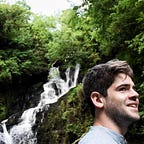A Summer Snapshot of the Aran Islands.
I’m standing on an island, looking back, staring out over a series of smaller islands which lead inevitably back to the mainland. Behind and below me the wild Atlantic roars onto the rocks, untameable. But it’s peaceful — one of the most peaceful places I’ve been. The only thing which risks catching me off guard is the hum of bumblebees as they duck and weave overhead. I never imagined I’d encounter bees here, on the edge of the world. It’s somewhat evocative of Yeats’ ‘bee loud glade’ except that this is no lake isle of Inis Free. It’s the Atlantic Isle of Inis Mór.
For some reason, I’m looking back towards land instead of out over the Atlantic, squinting as my eyes reach the point where it meets the sky in enormity and nothingness. I turn and realise that perhaps it’s something to do with the sheer drop a few metres in front. You have to hold your breath just to inch closer to the edge and, should you inch too far, you’d likely spend the rest of eternity holding that same breath. I move back and we begin to make our way down from Dún Aengus and back to our rented bicycles. The land is littered with this island’s history and hardships. Dry stone walls guide us down from the cliff and frame the landscape around us. If it weren’t for the necessity of having food to eat, these rocks would have remained scattered at nature’s will. Instead, they have become part of the defining imagery of the Aran Islands. Elsewhere, small cottages are either in a state of aged ruin or post-boomtime abandon. Whatever the cause for decrepitation, they decorate the landscape and preserve its low-budget-American-film-about-Ireland appearance.
Life here is lived leisurely. Out of habit, I look both ways when crossing the single track, grassy mohawked road, but there really is no need. These otherwise empty roads are ruled by the two wheeled tourists on bike trips around the island. In a place which is celebrated for Irish being the first language, it finds itself outnumbered; sharing the air with innumerable other languages. But Irish is happy with its place. Pubs, cafes and restaurants are always jammed, and shops make business selling Claddagh rings and Aran ganseys. Ireland is as much a product as it is a destination on this island, but the balance is maintained as well as that of the rocks in the dry stone walls.
As a consequence, there seems not to be the small town mentality so epidemic in many other parts of rural Ireland. A saturated soup pot of accents and skin tones leads you to feel undeniably connected to the rest of the world, despite seeming on its very edge. Often I wonder whether tourists feel this connection, or whether they come here with the intention of disconnecting from the rest of the world entirely. Some must think they’ve landed on a different planet. One where grassy verges run thin into moonscape rocks which dip and dive into crag and then ocean. And where rock recedes, an aquamarine tide rises and falls over brilliant white sand. The landscape is as variable and fickle as the weather. And yet the weather, as will always be of question in Ireland, has been remarkable. Short spits of rain have been quickly displaced by sunshine so that our raincoats have remained firmly stuffed into our rucksacks.
This morning I woke to watch the sunrise. As I walked the short distance to the beach, the violence of the Atlantic on the other side of the island could be heard from the side where it gently lapped against sand and toes. Aside from that, there was nothing but the sound of birds. Eventually signs appeared that the island was waking up. Men on bicycles unhurriedly slipped by and the early morning car ferry made its way over from Galway. By the time passenger ferries started arriving and unloading hordes of culture-thirsty tourists, the sun had risen high, and the rest of the island had woken. On our final day, my brothers and I were swimming in the harbour at the same time the boats were arriving. A group of sallow skinned Italian students briefly looked on in a sort of horrified amazement that we were voluntarily swimming in the Atlantic, before their attention was quickly stolen by the siopa na hÉireann — I expect they would barely have noticed us, had it been called ye olde Irish shop. It makes me wonder about the relationship this island has with tourism. It is simultaneously preserved and brought into the future because of its relationship with tourism. The case could be made that, without tourism, the island would have remained completely in the 1970s like the lesser explored middle island, Inis Meain. And equally, these old ways of life are only preserved because they can be used as unique selling points to entice tourists to spend their money here. Tourism has brought a wealth of opportunities to this island, and has encouraged it to stay largely the same.
Before long, we were out of the water, dressed and boarding our boat — named the Happy Hooker — as it got set to bring us back from the edge of the world. The island will be here when I next want to visit, I’m sure. The Atlantic might find it in her interest to rearrange the shape of the coastline a little, and the faces of the traditional Irish musicians might be rounder and redder. But you can rest safe in the knowledge that there exists, on Europe’s western edge, a microcosm of culture clash and cohesion, where roads are ruled by tractors and tourists and where doors and hearts will continue to be open to the world.
(all photos by me, on Kodak film.)
